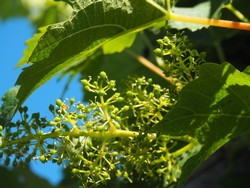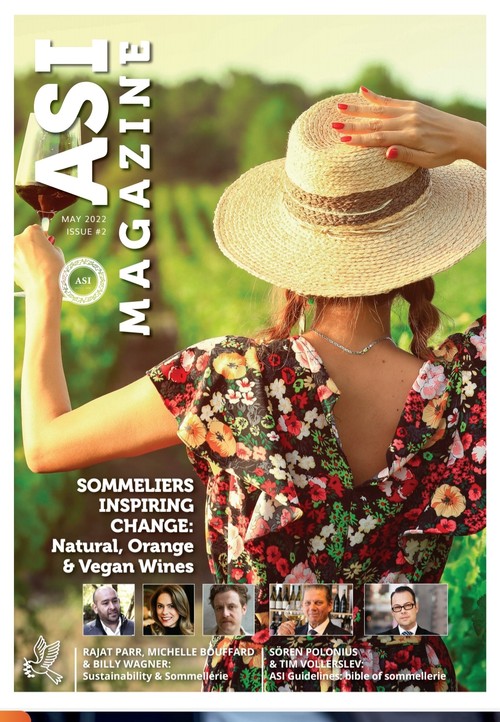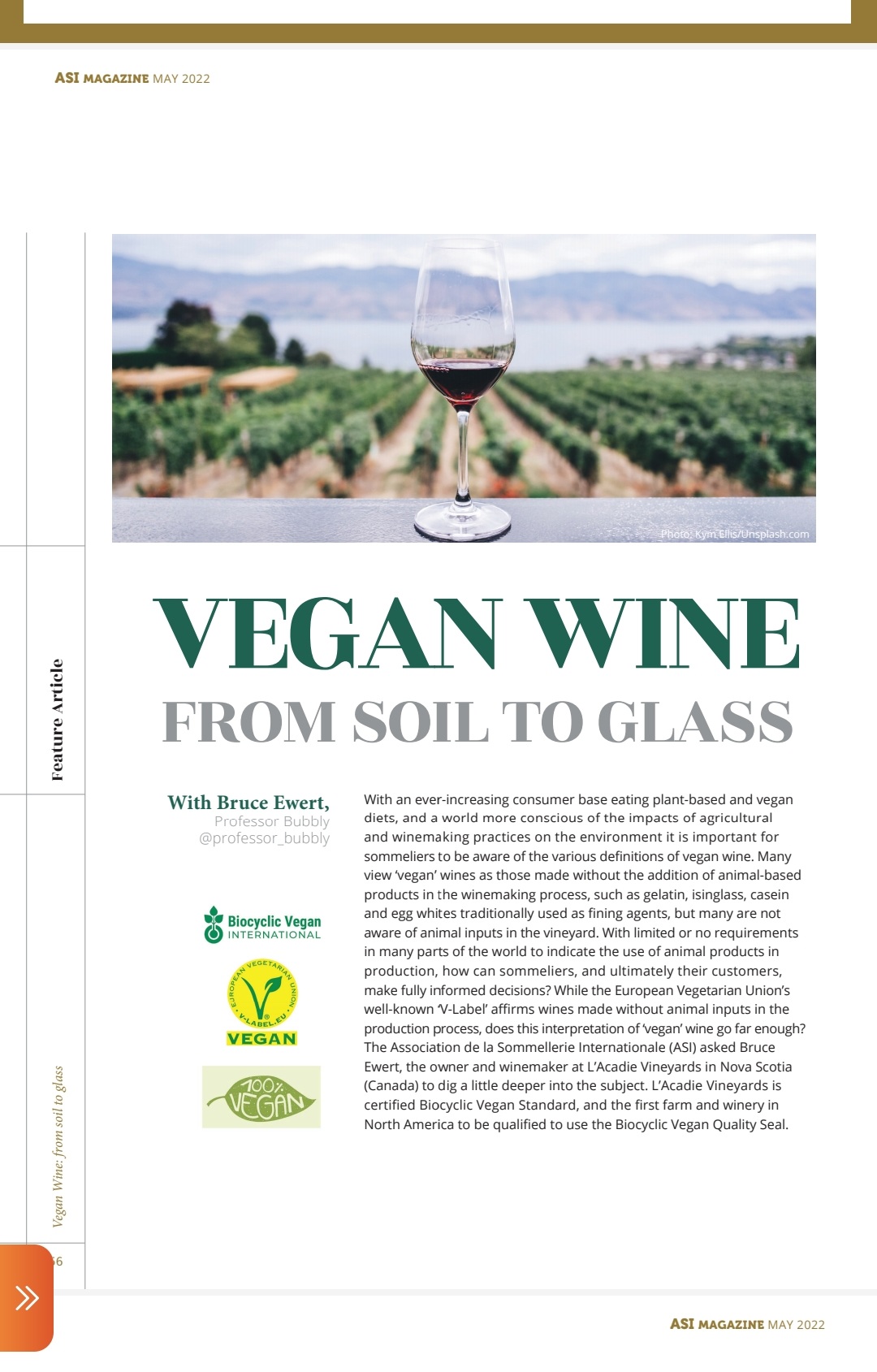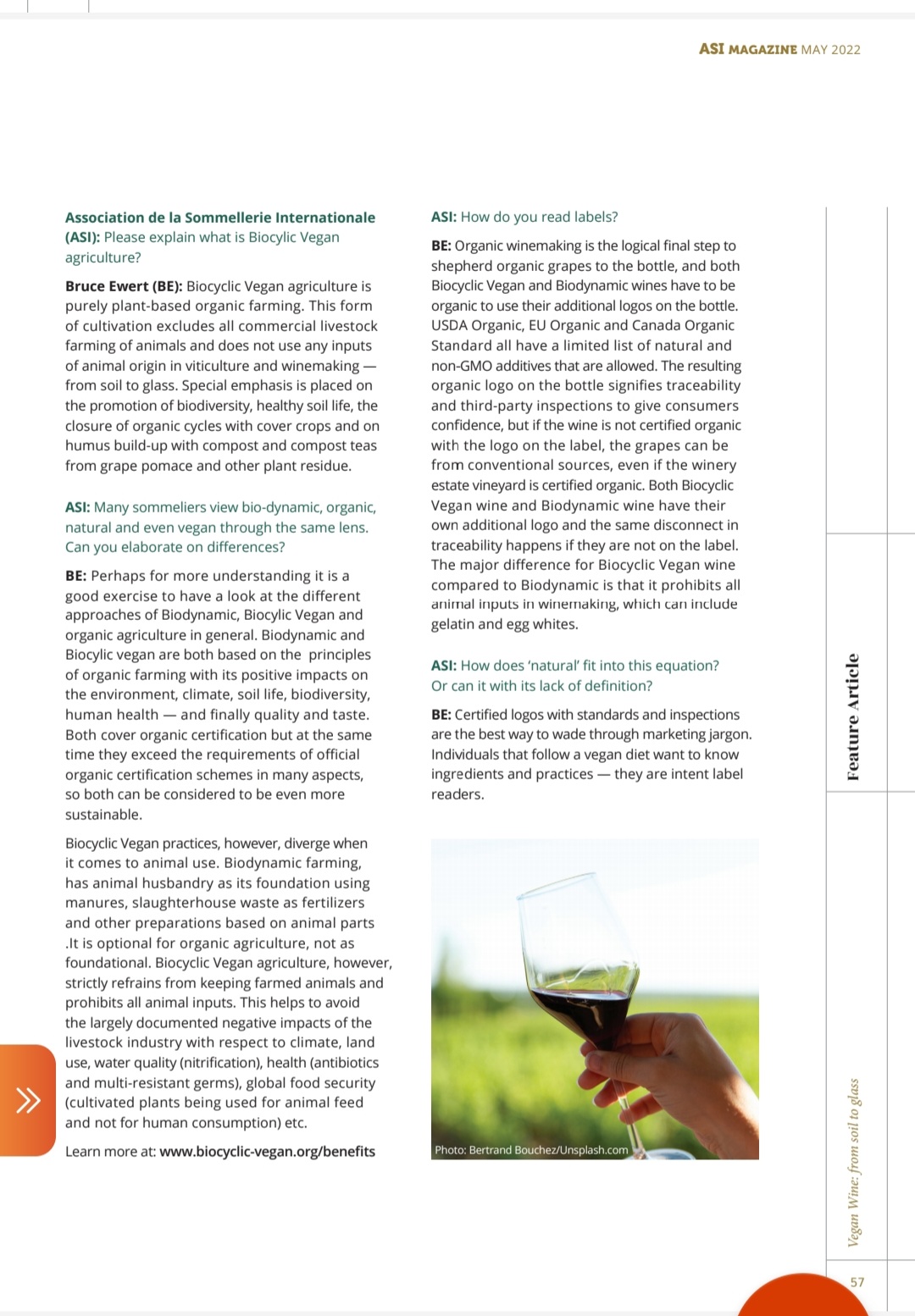L'Acadie Vineyards Blog
Welcome to the L'Acadie Vineyards blog and winery news
PIWI Grape Varieties
PIWI refers to grape varieties that have a high level of resistance to mildew diseases, notable Powdery Mildew and Downy Mildew. The acronym is from the German term “Pilzwiderstandsfähige Reben”. Why is this term so popular right now? There is a huge interest by wine trade and industry in growing and making wine more sustainably and part of this equation is planting more disease resistant vines. More disease resistance means less sprays, and in a conventional vineyard that means less costs and less pesticide residues in your wine. But how do hybrid grape varieties and organic grape growing fit into this concept?
Hybrids
PIWI is a general term that includes hybrids but packaged as a hipper, more marketable term. Hybrids, a breed between European varieties and North American varieties, got a bad rap after they were planted in France as a solution to phylloxera-devasted vineyards in the late 1800’s and in Canada’s early wine days. Today, they are on approved grape variety lists for many European wine regions, British Columbia and Ontario, although somewhat marginalized, and of course celebrated in Nova Scotia and other north-eastern regions. They are gaining back popularity and we have consistently earned international awards for our L'Acadie Blanc sparklings.
Organic grape growing and PIWI
As mentioned, selecting disease resistant grape varieties are part of the sustainability equation in the sense that there are less chemical sprays. But what about an organic vineyard? This is where the dial moves and less resistant varieties can still be grown sustainably. We use the following organic strategies in our less resistant vinifera blocks of Chardonnay, Sauvignon Blanc and Pinot Noir: pruning for air circulation, horsetail and compost teas, sulfur and copper. There is also a philosophy that the vines can live with mildew diseases as long as we can keep the clusters disease-free, a sort of probiotic strength approach that is achieved by timing of sulfur and copper application around the flowering stage.
Wine Library Releases
Library Releases
Aged wines from cool climates are ideal for exploring
Our wine library is extensive and delicious. We hold back bottles from every vintage and age them in ideal conditions for our own reference and for periodic library releases to wine club members and key wine accounts. Past releases include 10-year aged Estate L’Acadie to show off how these minerality-dominant dry organic wines age and develop, our cool climate consistently granting a seamless longevity statement every vintage, and 10-year aged appassimento reds with tannins and flavours of their youth developing into supple tannins with dried fruit and jammy directions, yes jammy, a descriptor usually reserved for hot climate reds. 2014 Estate L’Acadie and 2012 Passito are currently available at Peacock Wine Bar in Halifax. Traditional method sparklings tend to develop richer characters when aged on cork and we have 2007 Prestige Brut Estate planned for a release. Best way for updates is receiving our newsletter.
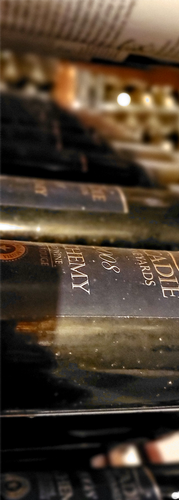
This year our Gaspereau winery will be releasing 2008 Alchemy from the library exclusively for wine club members. Alchemy was Nova Scotia's first appassimento Amarone-style red, a worthy style for our cool-climate region, and refers to early scientists, or alchemists, searching to transform ordinary metals into gold. We did 5 years of research with Italian researchers and Kentville Research Centre to hone our grape drying technique and our inaugural release of the 2006 vintage won gold at the All-Canadian Wine Championships, quite fitting. 2008 Alchemy is an exceptional red wine carefully aged on cork for 14 years after 2 years in barrel and boasts complex, developed flavours of black cherry, toasted oak, & licorice.
Sign up for wine clubs here
Drink Less, Drink Better
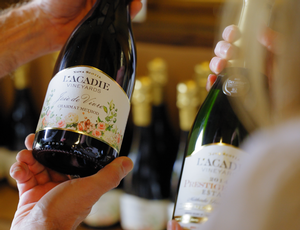
January is a good month to reset, reflect, plan and develop new healthier habits. Many are aiming to drink less alcohol and being more mindful of choosing wines when we do enjoy a glass. Vegan and organic wines are a delicious positive choice for the environment and your health.
There is plenty of research and information on vegan and organic farming benefits to soil, groundwater, air quality and bigger picture climate change, as well as individual health. In Europe, government funding for agriculture in most countries is tiered based on sustainability, with organic agriculture on the top pedestal. Recent examples include the Spanish region, Penedès, requiring all wineries to be organic, and the Italian government ruling that biodynamic farming, a largely animal-based practice, is not as sustainable as organic.
Read blog Why we are biocyclic vegan
Read more DO Penedès: new rules and aiming for Spanish wine’s top-tier
Read more Biodynamic farming favoured by Sting sees bill blocked in Italy
Most wine regions in Canada have identified economic impact study benefits for choosing local wine. In Nova Scotia, a local bottle contributes $76.73 and an import only $16.57 – very dramatic reasons to buy local. We should extend studies like this to include health benefits of sustainable wine and put monetary value on consuming less pesticide residues in your glass, reversing climate change from less carbon emissions, healthier soils and cleaner water and air. Governments have identified rising health care costs associated with certain lifestyles and, much like European governments supporting organic farming, they offer incentives for healthier choices. A “Health Impact” study for organic vegan wine could help guide their programs.
Organic coupled with local is always better especially when your local wine region is a cool climate producing naturally moderate alcohol wines. Instead of reaching for an organic Malbec from Chile at 15% alcohol, try an organic sparkling wine from Nova Scotia at 11% alcohol. Make your Tuesday night wine or your Friday night wine a celebration of health.
Read about our Vintage Cuvee in Vine Routes article 6 favourite vegan and earth-friendly wines
The Right Wine for the Right Whale
Introducing our 2022 Tidal Bay!
This is our third vintage of this appellation wine that eloquently showcases our province’s unique ocean-influenced terroir: we chose to highlight our estate-grown L’Acadie Blanc which displays minerality & subtle saline reminiscent of the sea, thanks to our ancient sea-bed soil. Our terroir is displayed cleanly & prominently, largely due to the fact that we are organic and foster a living soil.
We are the first organic vineyard & winery in Nova Scotia and the first Biocyclic Vegan farm & winery in North America. Our Earth-friendly practices follow through from soil to glass. The first pick for this wine in September was from vines traditionally sourced for our Prestige Brut Estate, with a deeper layer of humus-rich topsoil that brings our Tidal Bay a fresh acidity & crisp citrus flavours. A later pick in October from a different vineyard block complements the freshness with richer tropical notes such as mango.
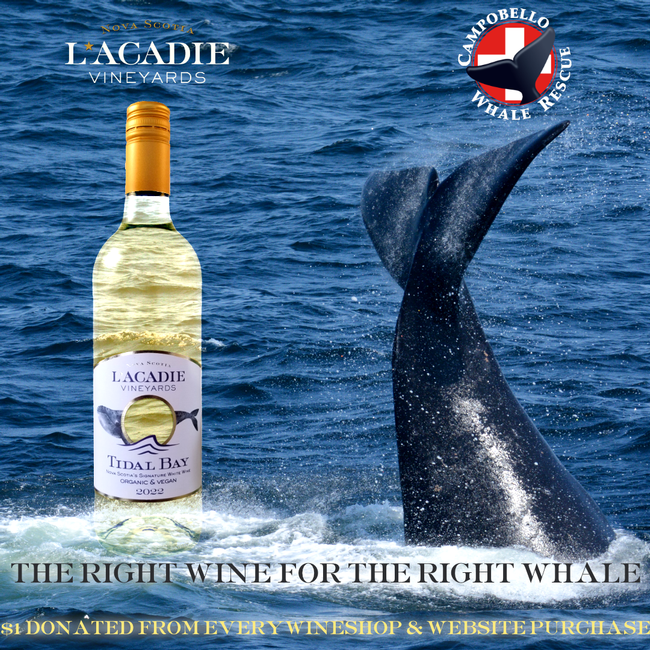
Our wine industry, and subsequently the Tidal Bay appellation, could not exist as it does without our ocean-influence from the Bay of Fundy. This year we have decided to help restore balance in our local marine ecosystem by partnering with the Canadian Whale Institute & Campobello Whale Rescue Team to help save the severely endangered North Atlantic right whale. $1 from every bottle of Tidal Bay sold in our wineshop & on our website will be donated to the Campobello Whale Rescue Team of the Canadian Whale Institute.
“The Campobello Whale Rescue Team of the Canadian Whale Institute is an organization of fishers, scientists and conservationists. They have firsthand knowledge of maritime waters, fishing gear and whale behaviour. Team members are trained in the use of specialized equipment to disentangle large whales from fishing gear, and to work with weir owners to release entrapped whales. The CWRT is licensed and permitted by Fisheries and Oceans Canada (DFO) to disentangle whales in the Maritimes, Gulf of St. Lawrence & Quebec. They work in coordination with DFO, the Marine Animal Response Society (MARS), and the Réseau Québécois d’urgences pour les mammifères marins (RQUMM) in partnership with Équipe de Desempêtrement du Golfe (EDG).”
Pick up a bottle for the weekend & enjoy a glass of wine for a good cause! Order Tidal Bay
How to Serve Sparkling Wine
Opening
Keep your hand on the cork! Release the cage with one hand and keep the other hand on the cork. Hold it and twist the bottle until you feel the pressure pushing it out. Get the perfect "pffftt" like a master sommelier, or a crowd pleasing "pop!" by letting it come out slower or faster. This video from our friends at Taste of Nova Scotia is a good primer on opening a bottle of sparkling,
Pouring
Always chill sparkling wines to fridge temperatures (4C) to enhance retention of bubbles. A flute is ideal but larger glass bowls better coax the aromas from well-aged wines like Prestige Brut Estate . Make sure the glass is clean and doesn't have soap residue. A full serving is 4 ounces (120ml) and to enhance enjoyment of aromas only fill to 1/3 to 1/2 full....and fill more often. Pro tip: tilt the glass and gently pour to preserve bubbles. No need to swirl - the bubbles will bring the toasty aromas to your nose.
Storing
Use a champagne stopper that secures onto the glass ring of the bottle, the same area that the wire cage held onto.....avoid expanding-style of stoppers - they can become rockets if too much pressure builds. Should keep for 3-5 days in fridge.
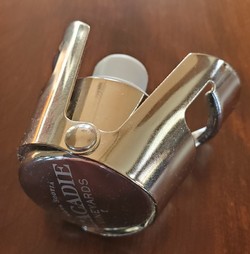
Champagne stopper available in our wineshop
Food Pairings
Many seafoods pair well with sparkling wine - "what grows together, goes together" is a favourite maritime expression. Think mussels, lobsters and oysters. But don't stop there - consider any food that has a salty component like potato chips and popcorn. Of course mild chesses are always a hit with guests, especially an assortment of soft cheeses. For curried and spicy dishes, choose our most aromatic sparklings like Rose Brut, or consider trying our traditional method cider, Duncanson Brook Cider
Visit our Recipe page for ideas such as Vegan Carbonara paired with Joie de Vivre charmat sparkling
It's Wine Club Month!
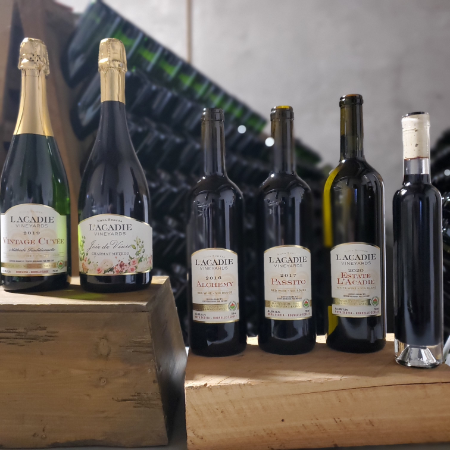
It's Wine Club month! Our L'Acadie Club is curated by winemaker Bruce Ewert and includes these exciting organic vegan wines being shipped in November from our Gaspereau winery, many of them new releases!
New Release 2019 Vintage Cuvee
2019 Joie de Vivre - our new charmat method sparkling
New Release 2016 Alchemy - dry appassimento red wine
2017 Passito - dry ripasso method red wine
2020 Estate L'Acadie - from our signature schist and slate soils
New Release 2019 Soleil - A new vintage of this favourite recioto sweet dessert style. Grapes dried to 40 Brix.
A new Sparkling Style
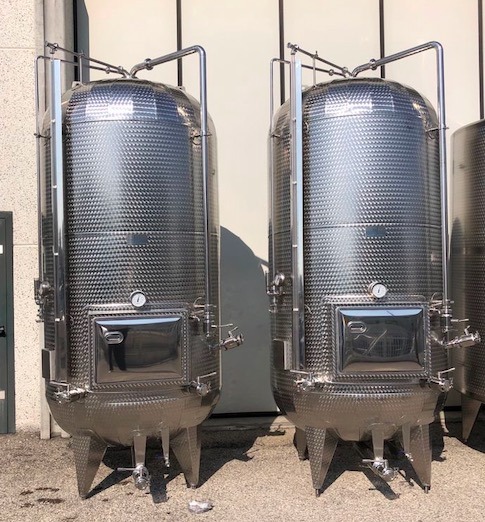
We are excited to announce that we will be releasing Joie de Vivre, a new sparkling style this summer - Charmat Method! The second fermentation will occur in specialized pressure tanks instead of traditional method sparkling bottles to produce natural bubbles the same way that Prosecco is made.
Joie de Vivre: noun [zwahduh vee-vruh] joy of living; a delight in being alive. We can all use more Joie de Vivre moments in our life and this wine embodies that philosophy, at a price that encourages more life enjoying moments!
This ambitious project has been three years in the making and answers calls from Nova Scotia restaurants, NSLC and other wine trade for a fresh early-release sparkling. Charmat method sparkling wine has a relatively brief time in tank to complete second fermentation and to keep wine fresh and fruity, compared to traditional methods of aging in bottle on its yeast lees for 2+ years. Fresh, creamy persistent natural bubbles and certified organic.
“Charmat method” will be the declared production method on front labels and assures you that it is not produced by artificial carbonation like many wines on our market. It complements our diverse Traditional Method sparkling portfolio and offers a new sparkling that is fresh, vibrant, fruity, and dry.
Charmat tanks are very specialized and our tanks are presently being shipped from the heart of the Prosecco region in Veneto, Italy, where Prosecco charmat production is famous.The project was delayed with the pandemic in hard hit northern Italy but we are thankful for their extra efforts. This specialized sparkling style requires experience and expertise, and winemaker Bruce Ewert worked with the style in Ontario early in his career.
Expected release of Joie de Vivre is June, in time for your barbecues, outdoor living and restaurant patio sipping.
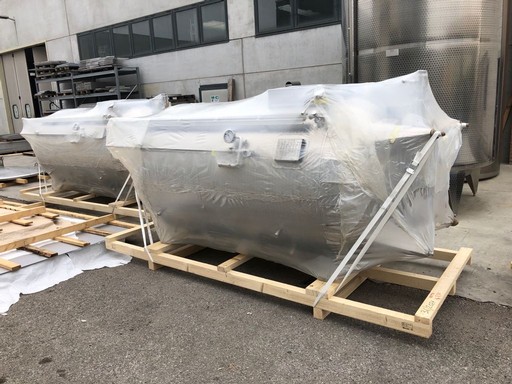
Which Annapolis Valley Wine Tours Will You be Taking in 2021?
There are high hopes that the 2021 tourist season will be better than 2020. Will we have the famous Atlantic Bubble again or will it be mainly staycations within the province? We don’t know, but we are planning on optimism and have many compelling reasons for you to visit our Gaspereau winery this year.
Wine tours of wineries in Nova Scotia are very popular. We are a family run organic vineyard in Gaspereau Valley and our Wolfville winery offers wine tastings, vineyard tours and even encourages visitors to bring their own picnic for food and wine pairings. We are the birthplace of traditional method sparkling wine and offer one of the most diverse sparkling wine portfolios of all the Nova Scotia vineyards and the most organic wine. Visit our wineshop and bring a bottle home to relive your day in the heart of wine country.
Wine Tasting and Tour Options – Season starts late May (date to be announced)
All tastings and tours are by appointment, Visit our website to book your tasting now: /Visit-Us
Sparkling Tasting – Four of our sparkling wines including wineshop exclusives, production methods and suggested food pairings
L’Acadie Tasting – an exploration of our diverse organic wines with three still wines and a choice of traditional method sparkling wine
A la Carte Tasting – you decide which wines that you would like to taste
Vineyard Tour – taste three focussed terroir wines while learning about our vineyard practices, organic ethos, terroir and sense of place.
Learn more about our tours and tastings on our website.
Industry partnerships are a valued component to our wine tour program and we are pleased to work with five tour companies in 2021. They also offer custom winery tours in the Wolfville area, so just ask them to include us and they will!
Is Wine Vegan?
Is wine vegan? Yes, all L'Acadie Vineyards wines are vegan and organic, and we also follow vegan viticulture. So what can makes other wines not vegan? We all know that wine is grown in the vineyard, that practices and weather can play a significant role in ultimate wine quality. So let's start there.
Vineyard management varies depending on varieties, vineyard location and philosophy. Our location is deeply rooted in Gaspereau, Nova Scotia and we grow several varieties - L'Acadie blanc, Leon Millot, Chardonnay, Sauvignon Blanc and Pinot Noir. Click here for more about our terroir. The latter varieties are in the vinifera family and are more sensitive to disease so require more attention. Strategies include hilling the trunks in winter, leaf removal next to clusters and shoot positioning for air circulation, periodic sulfur applications on the leaves and plant residue teas. That brings us to philosophy, which really has two camps - conventional and organic. We have been organic since first planting our estate in 2005/2006 and our nutrient management includes beet extracts for a nitrogen source rather than animal manure. Synthetic inputs are not allowed in organic systems and these include petroleum-based fertilizers, glyphosate weed killer, and a host of systemic and contact pesticides that ultimately make it into your wine.
Winemaking is the more direct source for non-vegan inputs. The most prevalent is gelatin, derived from animal slaughtering. It is a protein fining agent that is routinely added to hard press juices to reduce the bitter tannins that were squeezed from the skins. And there are other proteins used to similarly reduce bitterness and astringency in wines - egg whites for barrel aged reds, casein (cow milk) for correcting oxidized wine, and isinglass from fish bladders. So what do we use? Bentonite is a clay that has amazing clarification and stabilization benefits, and a riddling aid to help the yeast slide down the bottle for traditional method sparkling. For tannin management, we only make reds when the season gives us ripe tannins and phenolics(don't bother looking for 2018 and 2019 vintages), and after careful maceration techniques and aging in barrels we don't need to reduce astringency.
Organic winemaking is low intervention. And as Heather Rankin at Obladee Wine bar in Halifax said it once, "You have to know a lot to do a little". So very little inputs and essentially nudging the wine along its evolution path to become what it was meant to be in the vineyard, a wine with soul and transparency. Organic certifiers audit our grape sources and all our inputs, and the Canada Organic logo on our bottles is your assurance.
Join our organic wine clubs! Click here for more information

